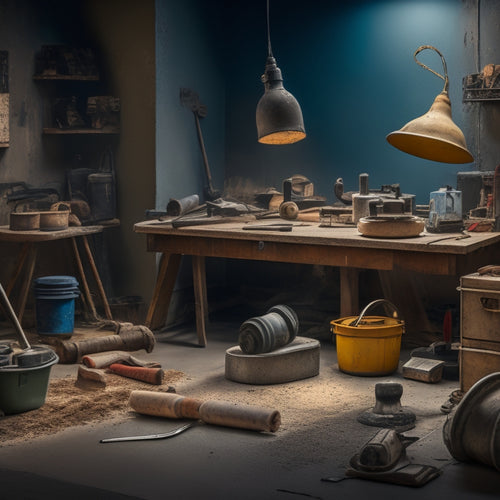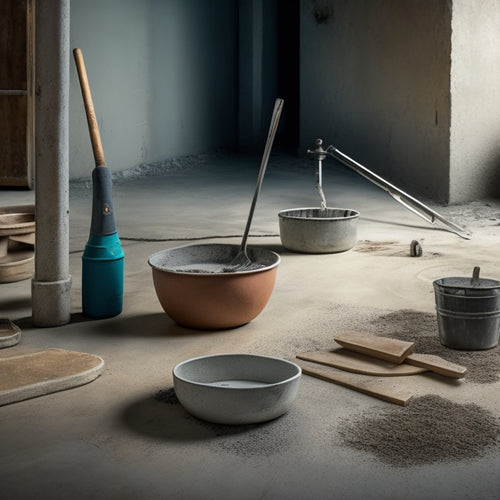
3 Must-Have Tools for Concrete Block Installation
Share
You'll need three essential tool categories for a successful concrete block installation: tamping tools, jointing and pointing tools, and cutting and chiseling tools. Handheld tampers, plate compactors, and jumping jacks guarantee peak compaction. Jointers, pointing trowels, and joint rakers help finish joints and fill gaps. Block saws, point chisels, and flat chisels are crucial for precision cutting and shaping. By having these must-have tools in your arsenal, you'll be well on your way to a strong, long-lasting concrete block installation. As you move forward, you'll discover the importance of proper tamping techniques, equipment maintenance, and more.
Key Takeaways
• A handheld tamper is essential for precise control and compacting small areas of concrete block installations.
• A jointer or jointing trowel is a must-have for filling and finishing joints, packing mortar tightly and smoothly.
• A block saw with a diamond-coated blade is vital for making precise cuts in concrete blocks.
• Proper tamping techniques, including consistent pressure and overlapping passes, ensure uniform compaction.
• A pointing trowel is necessary for precise pointing and filling small gaps in concrete block installations.
Essential Tamping Tool Options
When laying concrete blocks, you'll need reliable tamping tools to guarantee a stable and level foundation. Your options include handheld tampers, plate compactors, and jumping jacks. Each of these tools serves a specific purpose and is suited for different applications.
Handheld tampers are ideal for small-scale projects and provide precise control, while plate compactors are better suited for larger areas and offer increased efficiency. Jumping jacks, on the other hand, are perfect for compacting soil and granular materials.
Regardless of the tool you choose, mastering proper tamping techniques is vital. This includes applying consistent pressure, working in sections, and overlapping passes to guarantee uniform compaction. Additionally, regular equipment maintenance is necessary to prolong the lifespan of your tamping tools.
Clean and lubricate your tools regularly, and perform routine inspections to identify any signs of wear or damage. By selecting the right tamping tool and honing your skills, you'll be able to achieve a solid foundation that will last for years to come.
Critical Jointing and Pointing Tools
Properly filled and finished joints are essential to the structural integrity of your concrete block installation, and that's where your arsenal of jointing and pointing tools comes into play. These tools will help you master various jointing techniques and work with different pointing materials to achieve a strong and durable bond between blocks.
Here are the critical jointing and pointing tools you'll need:
-
Jointer or jointing trowel: Used to fill and finish joints, this tool helps you pack mortar tightly and smoothly.
-
Pointing trowel: A smaller, more precise version of the jointer, this tool is perfect for pointing and filling small gaps.
-
Joint raker or joint cleaner: This tool removes excess mortar and debris from joints, ensuring a clean surface for finishing.
- Pointing iron or pointing tool: Used to finish and shape pointing materials, this tool helps you achieve a smooth, even surface.
With these tools in your toolkit, you'll be well-equipped to master the art of jointing and pointing, ensuring a strong and long-lasting concrete block installation that will withstand the test of time.
Vital Cutting and Chiseling Tools
You'll need to precision-cut and chisel concrete blocks to fit them together seamlessly, and that's where your essential cutting and chiseling tools come into play.
For cutting, block saws are a must-have. These powerful tools can make precise cuts in concrete blocks, allowing you to fit them together with ease. When choosing a block saw, consider the type of blade you need - diamond-coated blades are ideal for concrete cutting.
When it comes to chiseling, you'll need a variety of chisel types to tackle different tasks. Point chisels are great for removing small amounts of material, while flat chisels are better suited for breaking up larger areas of concrete. You may also need a claw chisel for removing old mortar or a scaling chisel for scraping away debris.
With the right cutting and chiseling tools, you'll be able to precision-fit your concrete blocks and achieve a professional-looking finish. Don't skimp on quality - invest in durable, high-performance tools that will make your installation process faster and more efficient.
Frequently Asked Questions
What Safety Gear Is Necessary for Concrete Block Installation?
When working with concrete blocks, you'll need essential safety gear to protect yourself from hazards. You're required to wear safety goggles to shield your eyes from debris and dust, and steel-toed boots to prevent foot injuries from heavy blocks.
Can I Use Existing Soil as a Base for Concrete Blocks?
When evaluating existing soil as a base for concrete blocks, you'll need to assess soil stability and drainage considerations, ensuring the ground can handle the weight and water won't compromise the structure's integrity.
How Do I Prepare the Site for Concrete Block Installation?
As you commence your concrete block installation journey, you'll first need to 'clear the canvas' by conducting a thorough site assessment and soil testing to guarantee a solid foundation, literally and figuratively, for your project.
What Is the Ideal Concrete Block Laying Pattern?
When laying concrete blocks, you'll want to choose a pattern that balances aesthetics with structural stability. Consider a running bond or stack bond pattern to guarantee a strong, visually appealing foundation that gives you the freedom to build with confidence.
Do I Need to Seal Concrete Blocks After Installation?
You'll want to seal your concrete blocks after installation to prevent moisture damage; consider applying a silane-based sealer or a siloxane-based coating using various sealing methods to guarantee effective moisture prevention and long-lasting results.
Conclusion
You've made it to the final stage of concrete block installation. By now, you've realized that having the right tools is essential to achieving professional results.
The theory that 'a good craftsman never blames his tools' holds true here. With the must-have tools for tamping, jointing, pointing, cutting, and chiseling, you'll be able to secure a structurally sound and visually appealing structure.
Invest in these essentials to assure a job well done and a reputation that precedes you.
Related Posts
-

Top Concrete Resurfacing Tools for a Pro Finish
When it comes to achieving a professional finish in concrete resurfacing projects, you require the right set of speci...
-

Why You Need These Concrete Overlay Tools
When tackling a concrete overlay project, you need the right tools to achieve a flawless finish and avoid costly mist...
-

10 Best Tools for Sealed Concrete Finishing Success
When it comes to sealed concrete finishing success, you need a robust arsenal of specialized tools. Start with essent...


